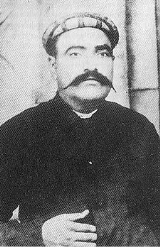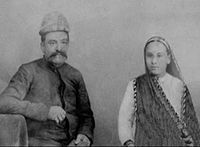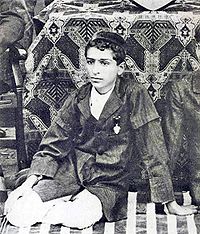
Sheriar Mundegar Irani
Encyclopedia
Sheriar Mundegar Irani (March 21, 1853 - April 30, 1932) was a mystic
and the father of Meher Baba
.
family in Khooramshar, near Yazd
, Iran
. His mother died when he was aged five, and he was then raised by his father Moondegar, caretaker of the local Zoroastrian funeral site. The Tower of Silence (dakhma) was a place where the dead were left exposed to the elements and to birds of prey, and Sheriar was often left in charge in these eerie surroundings while still a boy. Alienated from his peers by his occupation, oppressed by the Muslim
majority because of his religion, unschooled and illiterate, he left his birthplace at the age of twelve. For the next eight years he adopted the life of a solitary wandering dervish
. In 1874 he emigrated from Iran with his brother to India
In 1874 he emigrated from Iran with his brother to India
, in search of economic opportunities among the long-established Parsi community. After brief employment in Bombay
, he gave away most of the money he had saved and resumed his mystical quest. He wandered through Gujarat and Sindh
among other places for another ten years, begging only when he was hungry. Disappointed that nearly two decades of dervish
i had not led him to spiritual realization, he returned to Bombay where his sister Piroja now lived. Slowly integrating into conventional life, he reluctantly became betrothed to a young girl, Shireen Khuramshahi
, whose family had also immigrated from his birthplace. The marriage took place 8 years later in 1892 when Shireen came of age: she was 14 and Sheriar 39. To support his new lifestyle he became first a gardener and later the owner of a successful palm wine
business in Poona (present-day Pune
) where the couple moved in 1893. In all Sheriar and Shireen had nine children – seven sons and two daughters. Of these, three died in childhood: one son Shirmund at seven months, a second Jehangir at two years, and a daughter Freiny who died of plague
at age six in 1902.
In his spare time he learned to read and write his native Persian
, as well as the Gujarati
, Arabic
and Marathi
languages. This allowed him to continue his mystical studies in the textual realm, where he became recognized as an able scholar. Kevin R. D. Shepherd has linked him with the Ishraqi tradition of Iranian illuminationist philosophy, as mediated by the 16th-century Iranian Zoroastrian sage Azar Kayvan
. The circle of savants associated with Kayvan combined Zoroastrian, Sufi
, Neoplatonic
and other gnostic
beliefs with a nonsectarian
approach to the study of comparative religion
.


and not a part of Zoroastrianism. However, this fact is explained in Bhau Kalchuri's Lord Meher. Sheriar's personal philosophy incorporated elements from both Zoroastrianism and Sufi mysticism, a characteristic that he adopted from his father Moondegar who was an enigma to his Iranian Muslim neighbors because as a Zoroastrian he participated in both Muslim and Zoroastrian festivals and was a devout follower of a Muslim saint. Because there are no mystic, mendicant, or ascetic traditions in Zoroastrianism, Sheriar chose to practice an Islamic mystic path such as that of the Sufi mendicant. However he neither officially converted to Islam nor left his birth religion of Zoroastrianism. After his marriage, arranged by his sister Piroja to a Zoroastrian girl Shireen in India, Sheriar rejoined his Irani community in Poona, was a householder and followed all Zoroastrian practices. Thus he could be said to have returned to his Zoroastrian roots.
The general claim by Meher Baba's devotees that Sheriar's famous son was also Zoroastrian is supported by the fact that Meher Baba wore the Zoroastrian sudra (a muslin undershirt) and the 72-thread kusti girdle all his life. 'Meher' is a Zoroastrian theophoric name that reflects his father's devotion to the Yazata
Mithra
. Also Meher Baba always signed his name 'M. S. Irani' and never 'Meher Baba'. Considering his teachings, which often included Sufi references, it seems plausible then that Meher Baba acknowledged both Zoroastrian and Sufi philosophies like his father.
Mysticism
Mysticism is the knowledge of, and especially the personal experience of, states of consciousness, i.e. levels of being, beyond normal human perception, including experience and even communion with a supreme being.-Classical origins:...
and the father of Meher Baba
Meher Baba
Meher Baba , , born Merwan Sheriar Irani, was an Indian mystic and spiritual master who declared publicly in 1954 that he was the Avatar of the age....
.
Biography
Sheriar was born into a poor ZoroastrianZoroastrianism
Zoroastrianism is a religion and philosophy based on the teachings of prophet Zoroaster and was formerly among the world's largest religions. It was probably founded some time before the 6th century BCE in Greater Iran.In Zoroastrianism, the Creator Ahura Mazda is all good, and no evil...
family in Khooramshar, near Yazd
Yazd
Yazd is the capital of Yazd Province in Iran, and a centre of Zoroastrian culture. The city is located some 175 miles southeast of Isfahan. At the 2006 census, the population was 423,006, in 114,716 families....
, Iran
Iran
Iran , officially the Islamic Republic of Iran , is a country in Southern and Western Asia. The name "Iran" has been in use natively since the Sassanian era and came into use internationally in 1935, before which the country was known to the Western world as Persia...
. His mother died when he was aged five, and he was then raised by his father Moondegar, caretaker of the local Zoroastrian funeral site. The Tower of Silence (dakhma) was a place where the dead were left exposed to the elements and to birds of prey, and Sheriar was often left in charge in these eerie surroundings while still a boy. Alienated from his peers by his occupation, oppressed by the Muslim
Muslim
A Muslim, also spelled Moslem, is an adherent of Islam, a monotheistic, Abrahamic religion based on the Quran, which Muslims consider the verbatim word of God as revealed to prophet Muhammad. "Muslim" is the Arabic term for "submitter" .Muslims believe that God is one and incomparable...
majority because of his religion, unschooled and illiterate, he left his birthplace at the age of twelve. For the next eight years he adopted the life of a solitary wandering dervish
Dervish
A Dervish or Darvesh is someone treading a Sufi Muslim ascetic path or "Tariqah", known for their extreme poverty and austerity, similar to mendicant friars in Christianity or Hindu/Buddhist/Jain sadhus.-Etymology:The Persian word darvīsh is of ancient origin and descends from a Proto-Iranian...
.

India
India , officially the Republic of India , is a country in South Asia. It is the seventh-largest country by geographical area, the second-most populous country with over 1.2 billion people, and the most populous democracy in the world...
, in search of economic opportunities among the long-established Parsi community. After brief employment in Bombay
Mumbai
Mumbai , formerly known as Bombay in English, is the capital of the Indian state of Maharashtra. It is the most populous city in India, and the fourth most populous city in the world, with a total metropolitan area population of approximately 20.5 million...
, he gave away most of the money he had saved and resumed his mystical quest. He wandered through Gujarat and Sindh
Sindh
Sindh historically referred to as Ba'ab-ul-Islam , is one of the four provinces of Pakistan and historically is home to the Sindhi people. It is also locally known as the "Mehran". Though Muslims form the largest religious group in Sindh, a good number of Christians, Zoroastrians and Hindus can...
among other places for another ten years, begging only when he was hungry. Disappointed that nearly two decades of dervish
Dervish
A Dervish or Darvesh is someone treading a Sufi Muslim ascetic path or "Tariqah", known for their extreme poverty and austerity, similar to mendicant friars in Christianity or Hindu/Buddhist/Jain sadhus.-Etymology:The Persian word darvīsh is of ancient origin and descends from a Proto-Iranian...
i had not led him to spiritual realization, he returned to Bombay where his sister Piroja now lived. Slowly integrating into conventional life, he reluctantly became betrothed to a young girl, Shireen Khuramshahi
Shireen Sheriar Irani
Shireen Sheriar Irani , was the mother of Indian spiritual master Meher Baba.-Early life:...
, whose family had also immigrated from his birthplace. The marriage took place 8 years later in 1892 when Shireen came of age: she was 14 and Sheriar 39. To support his new lifestyle he became first a gardener and later the owner of a successful palm wine
Palm wine
Palm wine also called Palm Toddy also called "Kallu" written in Malayalam and கள்ளு in Tamil or simply Toddy is an alcoholic beverage created from the sap of various species of palm tree such as the palmyra, and coconut palms...
business in Poona (present-day Pune
Pune
Pune , is the eighth largest metropolis in India, the second largest in the state of Maharashtra after Mumbai, and the largest city in the Western Ghats. Once the centre of power of the Maratha Empire, it is situated 560 metres above sea level on the Deccan plateau at the confluence of the Mula ...
) where the couple moved in 1893. In all Sheriar and Shireen had nine children – seven sons and two daughters. Of these, three died in childhood: one son Shirmund at seven months, a second Jehangir at two years, and a daughter Freiny who died of plague
Bubonic plague
Plague is a deadly infectious disease that is caused by the enterobacteria Yersinia pestis, named after the French-Swiss bacteriologist Alexandre Yersin. Primarily carried by rodents and spread to humans via fleas, the disease is notorious throughout history, due to the unrivaled scale of death...
at age six in 1902.
In his spare time he learned to read and write his native Persian
Persian language
Persian is an Iranian language within the Indo-Iranian branch of the Indo-European languages. It is primarily spoken in Iran, Afghanistan, Tajikistan and countries which historically came under Persian influence...
, as well as the Gujarati
Gujarati language
Gujarati is an Indo-Aryan language, and part of the greater Indo-European language family. It is derived from a language called Old Gujarati which is the ancestor language of the modern Gujarati and Rajasthani languages...
, Arabic
Arabic language
Arabic is a name applied to the descendants of the Classical Arabic language of the 6th century AD, used most prominently in the Quran, the Islamic Holy Book...
and Marathi
Marathi language
Marathi is an Indo-Aryan language spoken by the Marathi people of western and central India. It is the official language of the state of Maharashtra. There are over 68 million fluent speakers worldwide. Marathi has the fourth largest number of native speakers in India and is the fifteenth most...
languages. This allowed him to continue his mystical studies in the textual realm, where he became recognized as an able scholar. Kevin R. D. Shepherd has linked him with the Ishraqi tradition of Iranian illuminationist philosophy, as mediated by the 16th-century Iranian Zoroastrian sage Azar Kayvan
Azar Kayvan
Āzar Kayvān , was a Zoroastrian high priest of Istakhr and native of Fars who emigrated to the Gujarat in Mughal India during the reign of the Emperor Akbar and became the founder of a Zoroastrian school of ishraqiyyun or Illuminationists...
. The circle of savants associated with Kayvan combined Zoroastrian, Sufi
Sufism
Sufism or ' is defined by its adherents as the inner, mystical dimension of Islam. A practitioner of this tradition is generally known as a '...
, Neoplatonic
Neoplatonism
Neoplatonism , is the modern term for a school of religious and mystical philosophy that took shape in the 3rd century AD, based on the teachings of Plato and earlier Platonists, with its earliest contributor believed to be Plotinus, and his teacher Ammonius Saccas...
and other gnostic
Gnosticism
Gnosticism is a scholarly term for a set of religious beliefs and spiritual practices common to early Christianity, Hellenistic Judaism, Greco-Roman mystery religions, Zoroastrianism , and Neoplatonism.A common characteristic of some of these groups was the teaching that the realisation of Gnosis...
beliefs with a nonsectarian
Nonsectarian
Nonsectarian, in its most literal sense, refers to a lack of sectarianism. The term is also more narrowly used to describe secular private educational institutions or other organizations either not affiliated with or not restricted to a particular religious denomination though the organization...
approach to the study of comparative religion
Comparative religion
Comparative religion is a field of religious studies that analyzes the similarities and differences of themes, myths, rituals and concepts among the world's religions...
.


The dichotomy of Sheriar's religion and mysticism
There is an apparent dichotomy in the fact that Sheriar is referred to in biographical sources as both a Zoroastrian and a Sufi dervish, as Sufism is a branch of IslamIslam
Islam . The most common are and . : Arabic pronunciation varies regionally. The first vowel ranges from ~~. The second vowel ranges from ~~~...
and not a part of Zoroastrianism. However, this fact is explained in Bhau Kalchuri's Lord Meher. Sheriar's personal philosophy incorporated elements from both Zoroastrianism and Sufi mysticism, a characteristic that he adopted from his father Moondegar who was an enigma to his Iranian Muslim neighbors because as a Zoroastrian he participated in both Muslim and Zoroastrian festivals and was a devout follower of a Muslim saint. Because there are no mystic, mendicant, or ascetic traditions in Zoroastrianism, Sheriar chose to practice an Islamic mystic path such as that of the Sufi mendicant. However he neither officially converted to Islam nor left his birth religion of Zoroastrianism. After his marriage, arranged by his sister Piroja to a Zoroastrian girl Shireen in India, Sheriar rejoined his Irani community in Poona, was a householder and followed all Zoroastrian practices. Thus he could be said to have returned to his Zoroastrian roots.
The general claim by Meher Baba's devotees that Sheriar's famous son was also Zoroastrian is supported by the fact that Meher Baba wore the Zoroastrian sudra (a muslin undershirt) and the 72-thread kusti girdle all his life. 'Meher' is a Zoroastrian theophoric name that reflects his father's devotion to the Yazata
Yazata
Yazata is the Avestan language word for a Zoroastrian concept. The word has a wide range of meanings but generally signifies a divinity...
Mithra
Mithra
Mithra is the Zoroastrian divinity of covenant and oath. In addition to being the divinity of contracts, Mithra is also a judicial figure, an all-seeing protector of Truth, and the guardian of cattle, the harvest and of The Waters....
. Also Meher Baba always signed his name 'M. S. Irani' and never 'Meher Baba'. Considering his teachings, which often included Sufi references, it seems plausible then that Meher Baba acknowledged both Zoroastrian and Sufi philosophies like his father.

